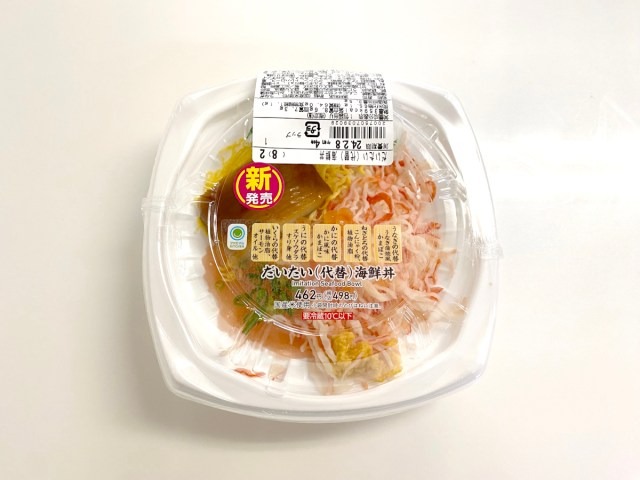
A taste of things to come?
Food insecurity is a constantly growing problem around the world, leading to a rethink about the ways we obtain and consume our food. But as luck would have it, we also live in an age of great technological advancements where soda can be made to taste like French fries and candy to taste like salmon, so even if some of our favorite foods become unavailable, there is hope that alternatives can be made.
Convenience store chain Family Mart has taken a proactive approach to this and began selling their Daitai Seafood Rice Bowl. The “daitai” in the name has a double meaning of both “vaguely” and “alternative” signifying that the seafood in this dish isn’t quite the real thing and is made with alternative ingredients.
With overfishing, climate change, and even political instability threatening the supply chain of a wide range of seafood, Family Mart has looked into some more sustainable sources to recreate the same dining experience for 498 yen (US$3.37) a bowl.
To find out if they succeeded, our Japanese-language reporter P.K. Sanjun picked up a bowl and sampled each of the faux toppings. But first, let’s make a rundown of all the imitation seafood this bowl has to offer, starting with the “crab” which is made from crab-flavored kamaboko steamed fish paste sausage.
Kamaboko has also been forged into the likeness of a “grilled eel” chunk.
This small side of “sea urchin” is actually a surimi paste made from whitefish such as Alaska pollock.
The “ikura” salmon roe was crafted mainly from a combination of vegetable oil and salmon oil.
And finally, the ground fatty tuna known as “negitoro” was replicated using konnyaku powder and vegetable oil.
P.K. honestly felt that these alternative toppings were not as appetizing looking as actual seafood, but realizing that this may be the future of food, he tried to keep an open mind while sampling each of the toppings one by one.
The “crab” didn’t taste like crab at all, but this kind of imitation crab has been popular for a long time so it wasn’t strange either.
Using the same method to recreate grilled eel was much more daring. Although they made the kamaboko surprisingly soft, it still didn’t match the texture of real eel. That being said, the taste of grilled eel is largely dominated by its distinctive sauce, so this version was pretty palatable too.
P.K. thought Family Mart did a pretty remarkable job of simulating the taste and mouthfeel of sea urchin though. He felt that with small enough portions, you could fool someone into thinking this was the real thing.
Speaking of which, it was a little difficult to judge the “ikura” because there were only a few “eggs” to eat. From what P.K. could tell, however, they were very accurate too. The taste was likely helped by the use of salmon oil.
The “negitoro” looked the part and seemed to have the right texture when P.K. poked it with his chopsticks. But the moment he put some in his mouth, he could feel his entire body cringe in revulsion. Taste is often a matter of opinion and in our writer’s, this was just bad.
So, overall, these seafood alternatives ran the gamut of quality but P.K. found the entire bowl edible thanks in part to the vinegared rice and soy sauce. Had he eaten it more casually and not laser-focused on each topping, it might have been more pleasurable too. That being said, he would be hard-pressed to recommend this to anyone based on its taste alone.
Still, anyone interested in it as an example of sustainable food production might want to take a bowl for the spin. If this is destined to be the future of food, at least Family Mart is getting an early start on developing it into something better. Hopefully, the taste will have improved considerably by the time we’re all expected to eat grasshoppers and giant water bugs.
Photos ©SoraNews24
● Want to hear about SoraNews24’s latest articles as soon as they’re published? Follow us on Facebook and Twitter!
[ Read in Japanese ]

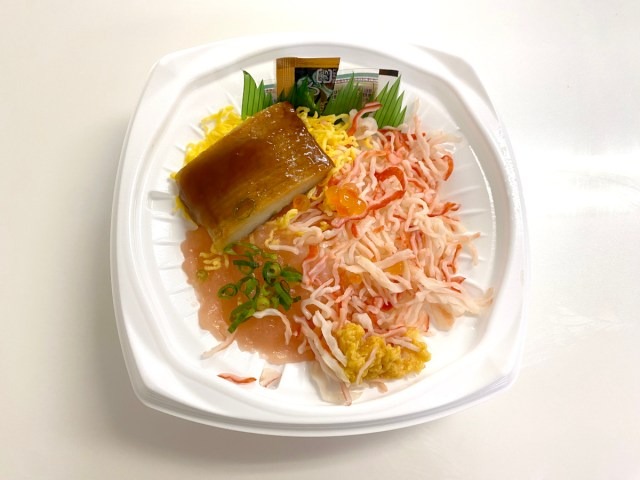
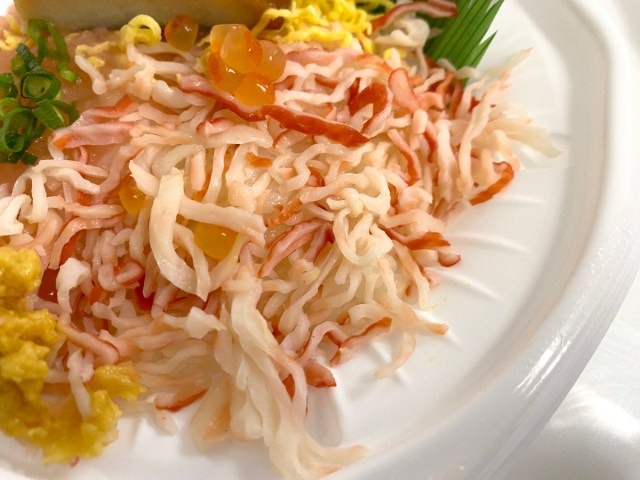
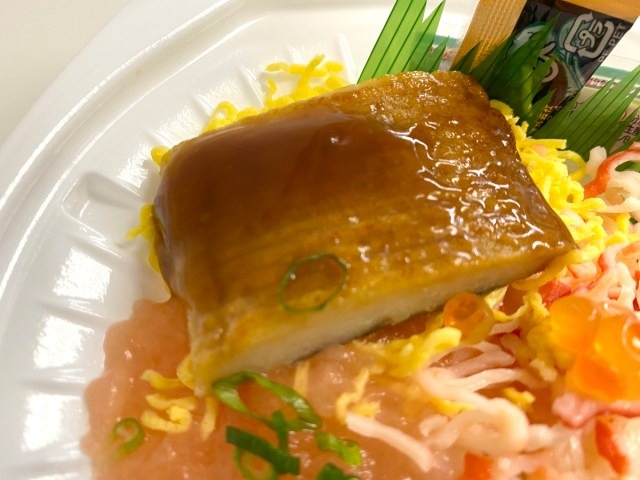
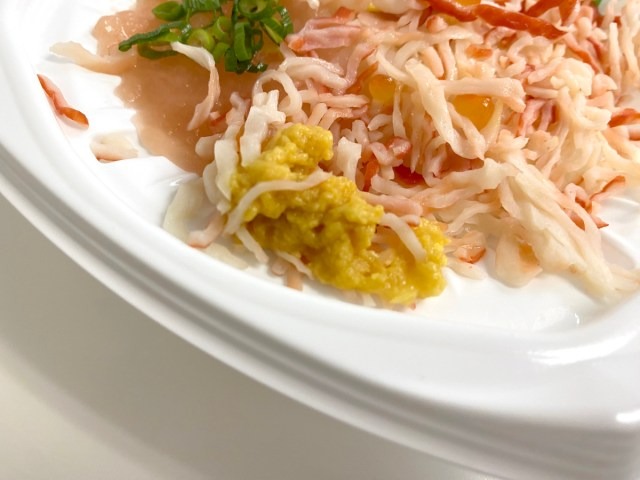
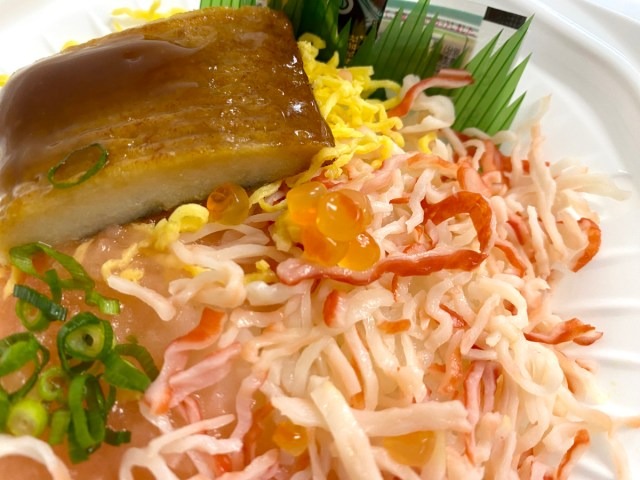
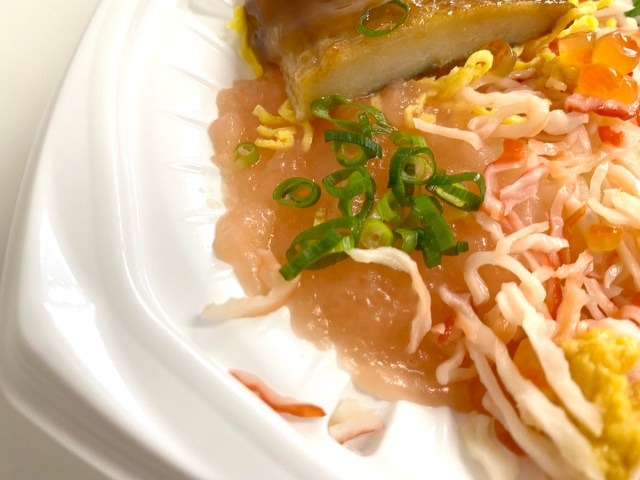
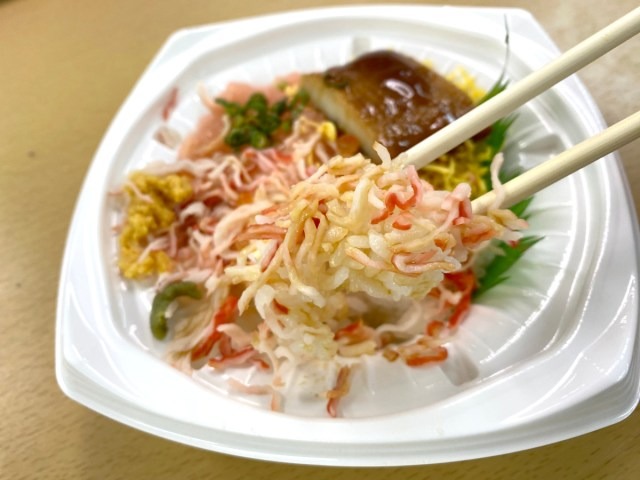
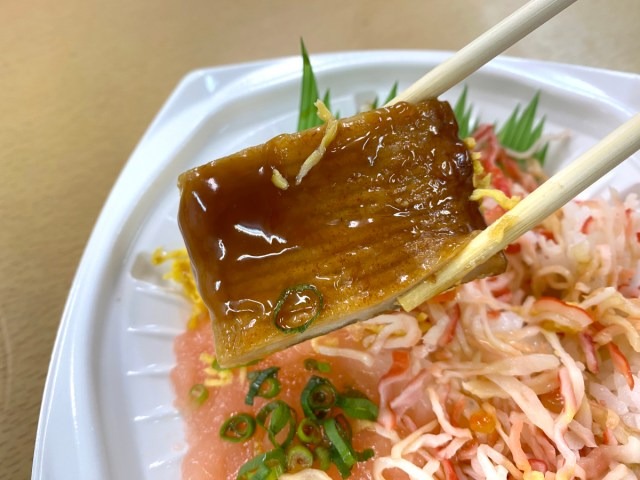
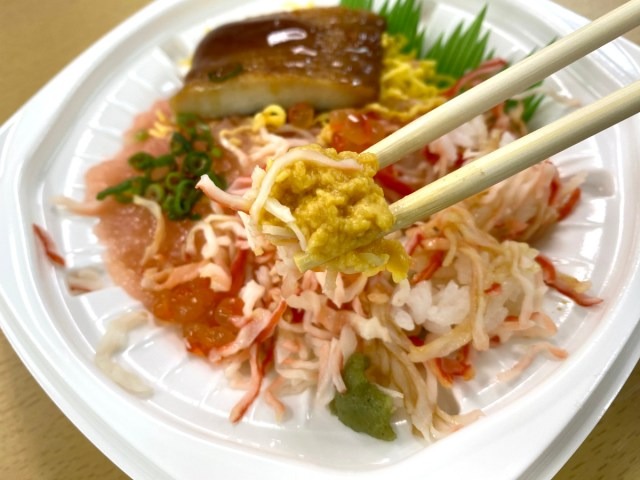
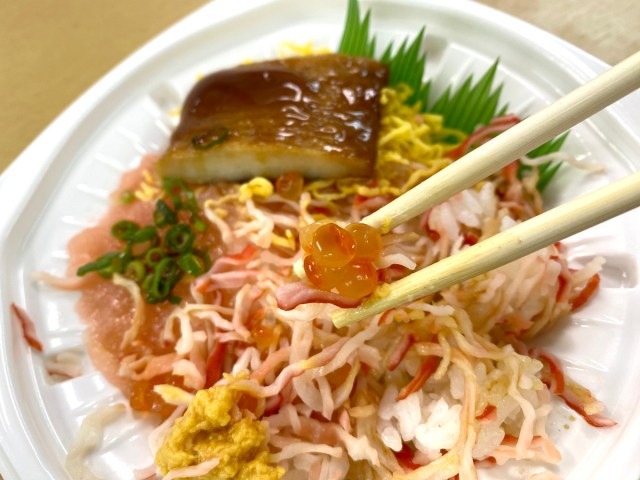
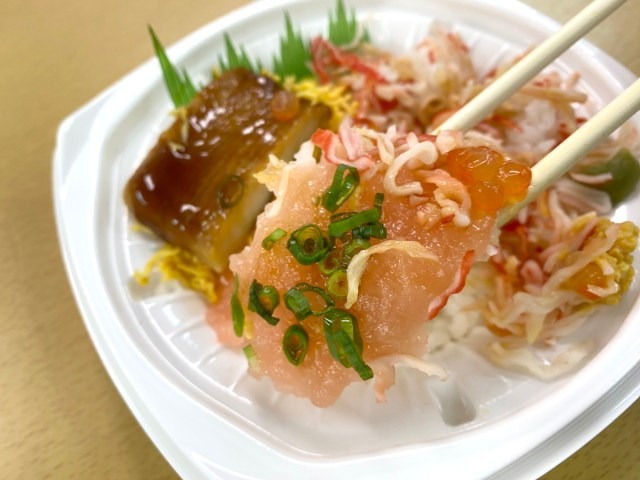
 Which Japanese conveyor belt sushi chain has the best salad sushi?【Taste test】
Which Japanese conveyor belt sushi chain has the best salad sushi?【Taste test】 Sure eel flavored potato chips are great, but here’s a recipe that’ll make them even better!
Sure eel flavored potato chips are great, but here’s a recipe that’ll make them even better! Is that restaurant in Tokyo with the giant mecha crab sign any good?
Is that restaurant in Tokyo with the giant mecha crab sign any good? Japan super budget dining – What’s the best way to spend 1,000 yen at Family Mart?
Japan super budget dining – What’s the best way to spend 1,000 yen at Family Mart? Dominique Ansel Bakery Japan now offering Singapore Crab… as an exquisite dessert! 【Pics】
Dominique Ansel Bakery Japan now offering Singapore Crab… as an exquisite dessert! 【Pics】 Foreigner’s request for help in Tokyo makes us sad for the state of society
Foreigner’s request for help in Tokyo makes us sad for the state of society Seaside scenery, history, and so many desserts on Yokohama’s Akai Kutsu【Japan Loop Buses】
Seaside scenery, history, and so many desserts on Yokohama’s Akai Kutsu【Japan Loop Buses】 Should you add tartar sauce to Japanese curry rice? CoCo Ichi makes diners an unusual offer
Should you add tartar sauce to Japanese curry rice? CoCo Ichi makes diners an unusual offer Japanese city loses residents’ personal data, which was on paper being transported on a windy day
Japanese city loses residents’ personal data, which was on paper being transported on a windy day Harajuku Station’s beautiful old wooden building is set to return, with a new complex around it
Harajuku Station’s beautiful old wooden building is set to return, with a new complex around it Red light district sushi restaurant in Tokyo shows us just how wrong we were about it
Red light district sushi restaurant in Tokyo shows us just how wrong we were about it Osaka governor suggests lowering voting age to 0 to curb population decline
Osaka governor suggests lowering voting age to 0 to curb population decline Japanese ramen restaurants under pressure from new yen banknotes
Japanese ramen restaurants under pressure from new yen banknotes Expensive Japanese nail clippers: Are they worth it?
Expensive Japanese nail clippers: Are they worth it? Japan’s massive matcha parfait weighs 6 kilos, contains hidden surprises for anyone who eats it
Japan’s massive matcha parfait weighs 6 kilos, contains hidden surprises for anyone who eats it McDonald’s new Happy Meals offer up cute and practical Sanrio lifestyle goods
McDonald’s new Happy Meals offer up cute and practical Sanrio lifestyle goods French Fries Bread in Tokyo’s Shibuya becomes a hit on social media
French Fries Bread in Tokyo’s Shibuya becomes a hit on social media Studio Ghibli releases new action figures featuring Nausicaä of the Valley of the Wind characters
Studio Ghibli releases new action figures featuring Nausicaä of the Valley of the Wind characters New private rooms on Tokaido Shinkansen change the way we travel from Tokyo to Kyoto
New private rooms on Tokaido Shinkansen change the way we travel from Tokyo to Kyoto Tokyo Tsukiji fish market site to be redeveloped with 50,000-seat stadium, hotel, shopping center
Tokyo Tsukiji fish market site to be redeveloped with 50,000-seat stadium, hotel, shopping center Beautiful Ghibli sealing wax kits let you create accessories and elegant letter decorations【Pics】
Beautiful Ghibli sealing wax kits let you create accessories and elegant letter decorations【Pics】 Studio Ghibli releases Kiki’s Delivery Service chocolate cake pouches in Japan
Studio Ghibli releases Kiki’s Delivery Service chocolate cake pouches in Japan New definition of “Japanese whiskey” goes into effect to prevent fakes from fooling overseas buyers
New definition of “Japanese whiskey” goes into effect to prevent fakes from fooling overseas buyers Our Japanese reporter visits Costco in the U.S., finds super American and very Japanese things
Our Japanese reporter visits Costco in the U.S., finds super American and very Japanese things All-you-can-drink Starbucks and amazing views part of Tokyo’s new 170 meter-high sky lounge
All-you-can-drink Starbucks and amazing views part of Tokyo’s new 170 meter-high sky lounge More foreign tourists than ever before in history visited Japan last month
More foreign tourists than ever before in history visited Japan last month New Pokémon cakes let you eat your way through Pikachu and all the Eevee evolutions
New Pokémon cakes let you eat your way through Pikachu and all the Eevee evolutions Disney princesses get official manga makeovers for Manga Princess Cafe opening in Tokyo
Disney princesses get official manga makeovers for Manga Princess Cafe opening in Tokyo Sales of Japan’s most convenient train ticket/shopping payment cards suspended indefinitely
Sales of Japan’s most convenient train ticket/shopping payment cards suspended indefinitely Sold-out Studio Ghibli desktop humidifiers are back so Totoro can help you through the dry season
Sold-out Studio Ghibli desktop humidifiers are back so Totoro can help you through the dry season Japanese government to make first change to romanization spelling rules since the 1950s
Japanese government to make first change to romanization spelling rules since the 1950s Ghibli founders Toshio Suzuki and Hayao Miyazaki contribute to Japanese whisky Totoro label design
Ghibli founders Toshio Suzuki and Hayao Miyazaki contribute to Japanese whisky Totoro label design Doraemon found buried at sea as scene from 1993 anime becomes real life【Photos】
Doraemon found buried at sea as scene from 1993 anime becomes real life【Photos】 Tokyo’s most famous Starbucks is closed
Tokyo’s most famous Starbucks is closed One Piece characters’ nationalities revealed, but fans have mixed opinions
One Piece characters’ nationalities revealed, but fans have mixed opinions We asked a Uniqlo employee what four things we should buy and their suggestions didn’t disappoint
We asked a Uniqlo employee what four things we should buy and their suggestions didn’t disappoint Princesses, fruits, and blacksmiths: Study reveals the 30 most unusual family names in Japan
Princesses, fruits, and blacksmiths: Study reveals the 30 most unusual family names in Japan Our Japanese reporter’s experience with crawfish in the US left him stunned
Our Japanese reporter’s experience with crawfish in the US left him stunned In celebration of Onigiri Day, we compare rice balls from three different convenience stores
In celebration of Onigiri Day, we compare rice balls from three different convenience stores I can’t believe it’s not fish eggs? Taste-testing Japan’s imitation “almost ikura”【Photos】
I can’t believe it’s not fish eggs? Taste-testing Japan’s imitation “almost ikura”【Photos】 What’s it like to eat eel from a Japanese vending machine?
What’s it like to eat eel from a Japanese vending machine? Haven’t found the perfect Father’s Day present yet? Here’re 10 gift ideas from Japan
Haven’t found the perfect Father’s Day present yet? Here’re 10 gift ideas from Japan We ate all eight kinds of cold noodles from 7-Eleven and here’s our favourites【Taste test】
We ate all eight kinds of cold noodles from 7-Eleven and here’s our favourites【Taste test】 Convenience Store Private Brand Showdown: Which of Japan’s Big Three has the best beef curry?
Convenience Store Private Brand Showdown: Which of Japan’s Big Three has the best beef curry? Which Japanese convenience store has the best steamed curry buns?【Taste test】
Which Japanese convenience store has the best steamed curry buns?【Taste test】 Can our writers’ taste buds pick out the luxury kamaboko fish cake from these two?
Can our writers’ taste buds pick out the luxury kamaboko fish cake from these two? Nissin Cup Noodle flavours become Umaibo snacks, and we try every one of them
Nissin Cup Noodle flavours become Umaibo snacks, and we try every one of them Mos Burger x Dassai sweet sake collaboration expands with new rice burgers and a konjac drink
Mos Burger x Dassai sweet sake collaboration expands with new rice burgers and a konjac drink Sushi chain bento combines raw fish with…sukiyaki?
Sushi chain bento combines raw fish with…sukiyaki? Ginza hotel serves up one of the best breakfasts in Tokyo
Ginza hotel serves up one of the best breakfasts in Tokyo Mr. Sato attacks a massive castle of seafood at a new restaurant in Tokyo Skytree’s Solamachi
Mr. Sato attacks a massive castle of seafood at a new restaurant in Tokyo Skytree’s Solamachi Sushi store makes waves in Japan for meal with a surprising 14-character katakana name
Sushi store makes waves in Japan for meal with a surprising 14-character katakana name Edible culture shock: Our Japanese reporter tries American barbecue for first time【Taste test】
Edible culture shock: Our Japanese reporter tries American barbecue for first time【Taste test】
Leave a Reply